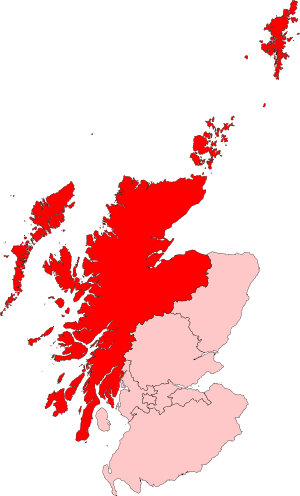Highlands and Islands facts for kids
The Highlands and Islands is a large and beautiful part of Scotland. It includes the Scottish Highlands and many islands like Orkney, Shetland, and the Outer Hebrides (also called the Western Isles). This area is known for its stunning landscapes, rich history, and unique culture.
Contents
What is the Highlands and Islands?
The exact size of the Highlands and Islands can change depending on how it is defined.
Historical Definition
Historically, the Highlands and Islands were sometimes defined by the Crofters' Act of 1886. This law helped people who farmed small pieces of land, called crofts. The area covered by this act included eight old counties of Scotland:
Modern Definitions
Today, different groups use slightly different definitions for the Highlands and Islands:
- Highlands and Islands Enterprise (HIE) is an organization that helps the economy grow in the region. They use a wider definition that also matches how Europe's statistics office (Eurostat) defines the area.
- Since 1999, there has been a special Highlands and Islands electoral region for the Scottish Parliament. This means people in this area vote for their representatives in the Scottish Parliament.
- For services like the former Highlands and Islands Fire and Rescue Service, the name referred to the modern council areas of Highland, Orkney, Shetland, and the Western Isles. The term Northern was also used for this area, for example, by the former Northern Constabulary (police force).
How the Area is Managed
The Highlands and Islands has its own ways of being managed, from police services to transport.
Police Services
As of early 2021, Police Scotland had six main police areas within the Highlands and Islands. These were:
- North Highland
- Inverness
- South Highland
- Orkney Islands
- Shetland Island
- Western Isles
Each of these areas has a local police commander. The police work closely with the local councils: Highland Council, Shetland Council, Orkney Council, and Western Isles Council.
Transport
Getting around such a large area, especially with many islands, requires good transport.
- The HITRANS (Highlands and Islands Partnership for Transport) was set up in 2006. It helps manage transport for most of the council areas, including Argyll and Bute, Highland, Moray, Orkney, and the Western Isles.
- Shetland has its own transport group called ZetTrans.
- The Helensburgh and Lomond area is covered by a different transport group called Strathclyde Partnership for Transport.
People and Economy
The Highlands and Islands is home to many people, and its economy has unique features.
Population and Work
In 2018, the population of the Highlands and Islands was estimated to be around 469,365 people. This was a small increase of 0.5% since 2011.
- More people here are self-employed compared to the rest of Scotland (11.0% vs. 8.7%).
- The number of people without jobs (unemployment rate) was lower than in Scotland generally (2.3% vs. 3.2%).
- The number of people who had jobs (employment rate) was higher at 78.6% compared to 74.7% for Scotland as a whole.
Recent Challenges
The worldwide pandemic in 2020 caused some changes to the economy.
- In summer 2020, the unemployment rate in the Highlands and Islands went up to 5.7%. This was much higher than the 2.4% in 2019.
- Some areas, like Lochaber, Skye, Wester Ross, and Argyll and the Islands, saw the highest increases in unemployment.
- A report in December 2020 showed that between March and December, the unemployment rate had increased by more than 97%. This suggested that the job market might face more challenges in 2021.


